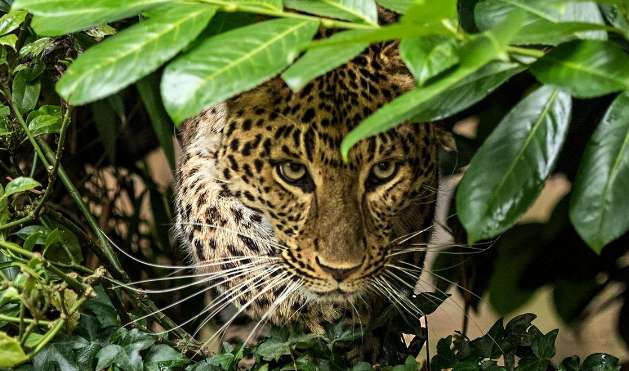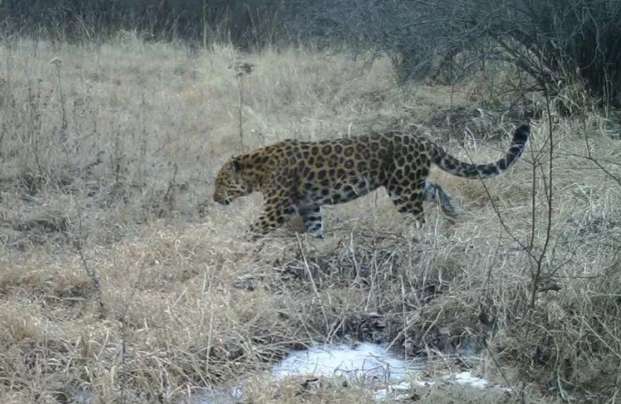Thanks to the achievements of ecological environment construction and animal protection, there have been more and more sightings of wild animals in recent years. For example, wild boars that were rarely seen even in rural forests in the past are now appearing frequently. In major cities, they even walked into bustling shopping malls, causing citizens to scream.
Compared to most ordinary people, some people who often deal with mountains and forests have a much higher probability of encountering wild animals.

Firefighters from Chengnanzhuang Town, Baoding City, Hebei Province recently encountered a wild animal when they were conducting mountain patrol training near Shangdaoba Village, and it was no ordinary animal. To be precise, it was a North China leopard.
During the mountain patrol, people suddenly heard a roar similar to that of a tiger and leopard coming from the trees not far away, which immediately aroused the vigilance of the team members.
In order to find out what kind of animal made the noise, a more courageous team member took the initiative to approach slowly and saw a huge animal in the bushes 6 or 7 meters away. The base color of the hair is earthy yellow with dark markings, making it look like a large cat.
Visually estimated that the animal weighed about 150 kilograms, and it became very ferocious when someone approached it. For safety reasons, the team members quickly took photos and then descended to a safe area. Afterwards, through photo identification and analysis of hair found at the scene, it was confirmed that it was a leopard.

Leopard is the general name for this type of animal. Because the patterns on its body are similar to ancient Chinese copper coins, it is also called a golden leopard, and its scientific name is Hua Leopard.
Leopards in the world can be divided into 9 subspecies, 4 of which are distributed in my country. They are: North China leopard, Far Eastern leopard, Indochinese leopard and Indian leopard.
The North China leopard is distributed in Ningxia, Shaanxi, Shanxi, Hebei, etc.In North China provinces; Amur leopards are mainly distributed in Heilongjiang and Jilin in northeast my country; Indochinese leopards are mainly distributed in southwest my country; Indian leopards are mainly found in Xinjiang. Therefore, judging from the geographical distribution, the leopard discovered by the team members in Baoding, Hebei Province should be the North China leopard.
Among the four species of leopards in my country, only the North China leopard only lives in our country, so it is also called the "Chinese leopard". At the same time, it is also the most important of the four species of wild leopards in our country. kind.
According to the latest survey data, the number of wild North China leopards in my country is about 1,500. They are extremely precious wild animals and belong to the first-level national protected animals. They are truly rarer than the number of giant pandas.

According to the 2019 assessment report of the International Union for Conservation of Nature, there are only 8 areas in my country where North China leopards are confirmed to exist. Their habitats are scattered and inconsistent with each other, and their ecological corridors are incomplete.
The North China leopard is of medium size among all leopards. Most adults weigh between 40-75 kilograms. Their heads are rounder and their proportions are smaller than those of tigers. They look relatively well-proportioned.
There is no doubt that the leopard is also a big cat and is classified into the ranks of large predators. However, compared to lions and tigers, leopards have more comprehensive skills. They are good at climbing trees and swimming, and their prey also involves aquatic, terrestrial, and arboreal animals.
Leopards are particularly good at climbing trees. In some habitats with high survival pressure, after leopards capture prey, they often drag it up the tree before eating to prevent it from being snatched away by other predators. .
In the forest, the ecological niche of leopards is second only to tigers, so Chinese people often call leopards the "two kings". In the past, our country was also a big "tiger and leopard" country, with many tigers and leopards.
The South China tiger, in particular, has a wide distribution range and its habitat covers most regions such as North China, East China, Central China, South China, and Southwest China. It is the most numerous tiger in my country and can be found in most forests. traces.
In the forest ecosystem, in the presence of tigers, the ecological niche of leopards is second only to tigers. However, since the 1950s, my country's tigers have been hunted in large numbers, and the population has dropped sharply, which has directly led to the disappearance of South China tigers in the wild. Without the tiger, the leopard took over the tiger's place and became the new king of beasts in the forest.
Nothing but a leopardIts inhibitory effect on large herbivores such as takin is obviously not as good as that of tigers, so it can only be said that it has taken over part of the tiger's ecological niche.
It is a good thing that the environment has improved and the number of wild animals has increased. As the flagship species of the forest ecosystem, leopards play an extremely important role in measuring ecology and maintaining system balance.
Over the years, the North China leopard population has continued to expand. For example, between 2020 and 2021, scientists monitored 39 North China leopards in an area of 2,400 square kilometers in Qingyang Ziwu Ridge. , 45 were monitored, with an annual growth rate of 15.38%.
Another survey of leopard habitats across the country shows that the leopard population across the country is on the rise. Compared with the past, the number of related sightings in areas where North China leopards are found has increased. Come more and more.
What needs to be remembered is that you must not disturb wild animals excessively. On the one hand, human activities and behaviors will have an impact on wild animals, and on the other hand, it is for safety reasons.
India is also a big country of tigers and leopards, with a considerable number of leopards. Different from leopards in my country, leopards in India seem to be more ferocious, and there are frequent incidents of entering villages to prey on livestock and hurt people. Why do leopards in my country seldom hurt people? What it boils down to is being alien to humans.
Because leopards in India often come into contact with humans and are accustomed to humans, they dare to attack. Leopards in my country mostly live in deep mountains and old forests, and are very unfamiliar with humans. The sense of strangeness makes them actively stay away from humans.
In research on man-eating tigers, scientists found that man-eating tigers often appear in the mangroves of the Sundarbans, and there are many healthy individuals there.
After in-depth research, it was discovered that local farmers often went into the mangroves to work. As soon as they visited the tigers here, they lost their sense of strangeness to humans. They found that humans are slower and easier to catch than wild prey. It turns into a man-eating tiger.
Leopards are also large carnivores and are extremely dangerous to humans. Therefore, when we encounter them in the wild, we must avoid them in time and do not disturb them.